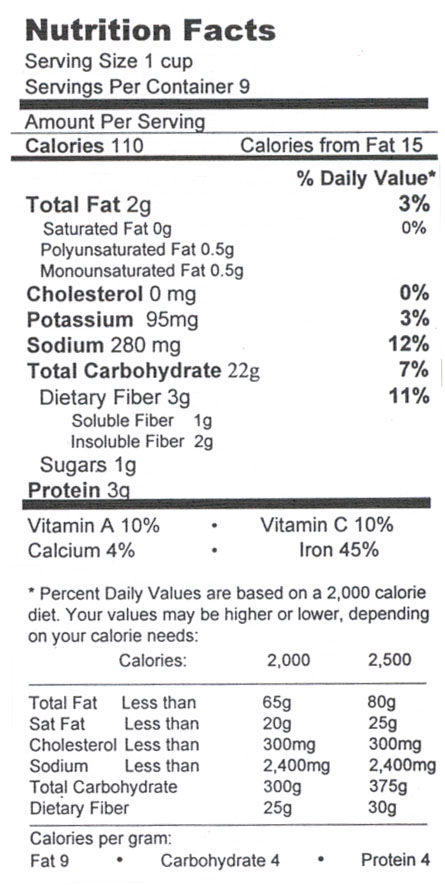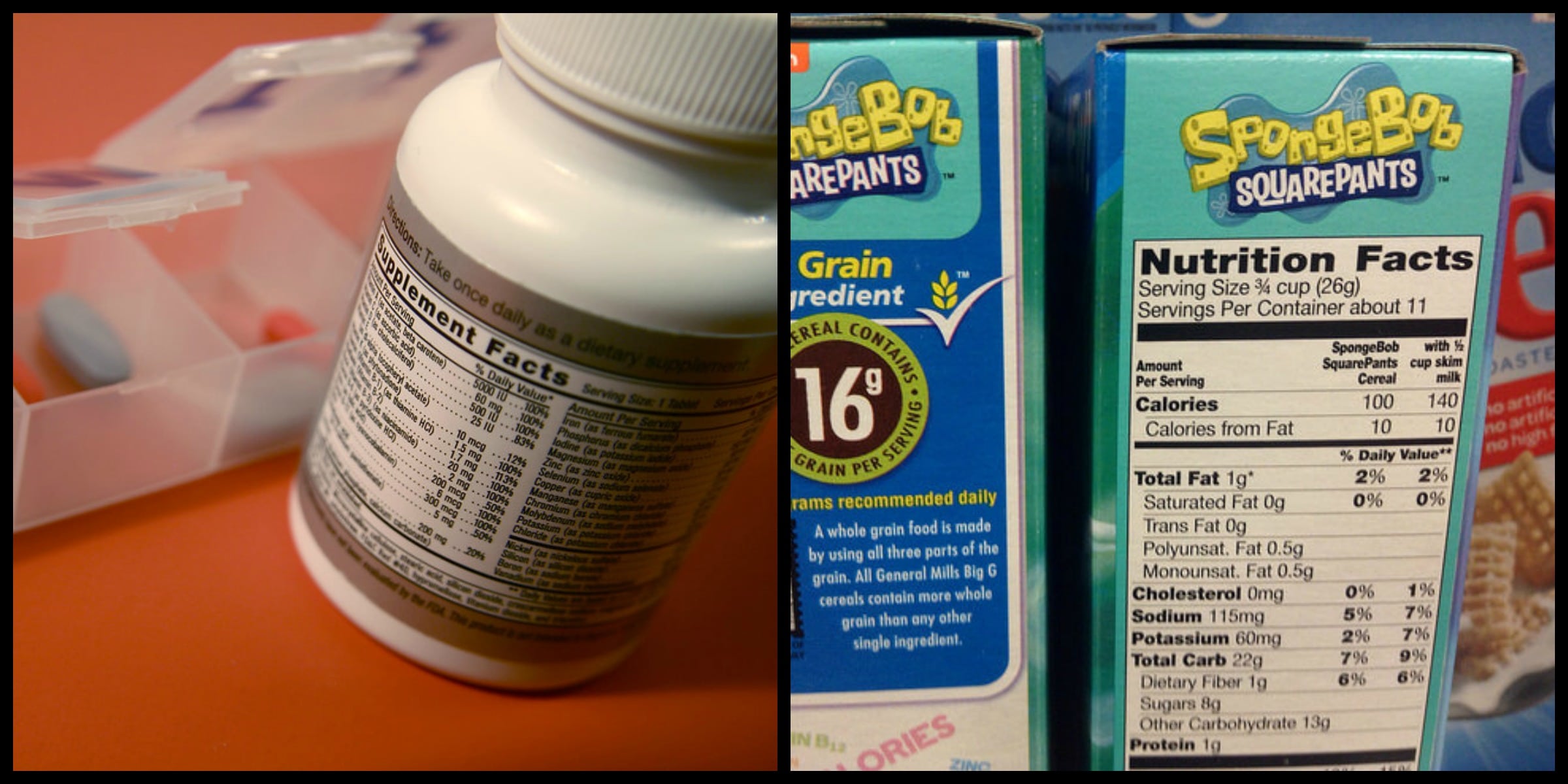45 understanding ingredients on food labels
Understanding Food Labels and Ingredient Lists: FAQs and Do's and Don'ts Fresh eggs. Foods with insignificant amounts of the nutrients on the required label, such as coffee, tea, spices, flavor extracts, and food colors. These may contain ingredient labels but are unlikely to contain nutrition facts labels. Packaged single-ingredient meat products, such as deer, bison, rabbit, quail, wild turkey, and ostrich. Understanding Ingredients on Food Labels - American Heart Association There are many terms used for sugar on food labels. You might see sugar listed as the fourth ingredient in a product and think it's not so bad. But sugar can also be listed as high-fructose corn syrup or corn syrup, agave nectar, barley malt syrup or dehydrated cane juice, to name just a few. Read more about sugar and sweeteners.
PDF Understanding Food Labels! - University of Arizona Understanding Food Labels! The following pages contain some great information about the food labels ... Label on sandwich ingredients and snacks to see how many calories and nutrients each contains! Consider different sandwich ingredients, such as: • ead options higher in dietary Br

Understanding ingredients on food labels
Understanding Food Labels | The Nutrition Source | Harvard T.H. Chan ... Under the Food Allergen Labeling and Consumer Protection Act of 2004, eight major food allergens—milk, fish, tree nuts, peanuts, shellfish, wheat, eggs, and soybeans—are required to be listed in a "contains" statement near the Ingredients list if present in a food. An example would be "contains wheat, milk, and soy." Understanding Food Labels - Optum Care Here are some helpful tips: Eat a variety of healthy foods. Focus on foods like lean meats and fish, whole-grain products, low-fat dairy, vegetables and fruits. Look at the ingredients list. Ingredients are listed from most to least. If sugar is the first ingredient, then that food is mostly made of sugar. Choose a diet low in fat and cholesterol. Food Labels | CDC If you eat the whole thing, you are eating 8 times the amount of calories, carbs, fat, etc., shown on the label. Total Carbohydrate shows you types of carbs in the food, including sugar and fiber. Choose foods with more fiber, vitamins, and minerals. Choose foods with lower calories, saturated fat, sodium, and added sugars.
Understanding ingredients on food labels. How to Read a Food Label - FoodAllergy.org In the ingredient list, using the allergen's common name. Using the word "Contains" followed by the name of the major food allergen—for example, "Contains milk, wheat.". In the ingredient list in parentheses, when the ingredient is a less common form of the allergen—for example, "albumin (egg).". With tree nuts, fish and ... Understanding Food Labels - Food Ingredient Facts Food labels are required to list all ingredients contained in the food in descending order based on the amount found in the final product. Most food additives are therefore found toward the end of the ingredient list. This indicates they are used in very small amounts in the food, generally less than two percent of the product. How to understand food labels - Eat For Health The Nutrition Information Panel on a food label offers the simplest and easiest way to choose foods with less saturated fat, salt (sodium), added sugars and kilojoules, and more fibre. It can also be used to decide how large one serve of a food group choice or discretionary food would be and whether it's worth the kilojoules. Understanding Ingredients In Food Labels | Eufic The quantity of a product's main or characterising ingredients must be declared, usually as a percentage, when the ingredient (or category of ingredient) appears in the name of the food, is normally associated with that food, or is given particular emphasis in the label (e.g. highlighted or pictured). Explaining ingredients
How To Read Food and Beverage Labels | National Institute on Aging Understanding food and beverage product dates There are three types of product dates commonly printed on packaged foods and beverages: "Sell by" tells how long the manufacturer suggests that a store should sell items such as meat, poultry, eggs, or milk products. Make sure you buy by this date. "Use by" tells how long items will be at peak quality. Understanding Food Labels and Health Claims - Maricopa low salt. Fewer than 140 milligrams of sodium. low cholesterol. Fewer than 20 milligrams cholesterol and 2 grams of saturated fat. lean. FEver than a set amount of grams of fat for that particular cut of meat. high. It contains more than 20% of the nutrient's daily value. good source. Easy Tips To Understand The Ingredient List On Food Labels Sugar, sodium and saturated and trans fats have a myriad of monikers. Sugar, for example, may appear as sugar, high fructose corn syrup, agave nectar, brown rice syrup, honey, molasses and a slew of words that end in "ose" (think glucose, fructose, maltose and galactose). Worried about sodium? Understanding Food Labels | RxWiki In terms of trans fat, if the label says a food contains "0 g" of trans fat but includes "partially hydrogenated oil" in the ingredient list, the food actually contains some trans fat. However, it contains less than 0.5 grams per serving. But you may end up eating too much trans fat if you are not aware.
A Complete Guide to Reading and Understanding Nutrition & Ingredient Labels An ingredient that is present in 2% (or less) by weight isn't subject to the same regulations and instead may be listed at the end or marked with a symbol. While these quantities may be small, even tiny amounts of hidden sugars or other unwanted ingredients can add up if eaten frequently. Watch for numbers that don't add up. Understanding food labels - Canada.ca Find information on food labels and how to understand them. Learn about nutrition facts tables, serving size, list of ingredients, % daily value and nutrition claims. Understanding Food Labels - Nutrition: Science and Everyday Application The FDA uses the following definitions for interpreting the %DV on food labels:4 5%DV or less means the food is low in a nutrient. 10% to 19%DV means the food is a "good source" of a nutrient. 20%DV or greater means the food is high in a nutrient. How to Understand and Use the Nutrition Facts Label | FDA Dietary fiber, vitamin D, calcium, iron ad potassium are nutrients on the label that Americans generally do not get the recommended amount of. They are identified as nutrients to get more of....

Understanding the food label is so important; you have to know what you're eating! | Nutrition ...
Understanding Food Labels | Food & Water Watch Country of Origin Labels. For now, the United States requires Country of Origin Labeling (COOL) on chicken, seafood, produce and some nuts that tells us basic information about what country our food was produced in - but the food industry has limited even this most basic element of transparency. Until late 2015, beef and pork were also ...
Understanding Food Nutrition Labels | American Heart Association When the Nutrition Facts label says a food contains "0 g" of trans fat, but includes "partially hydrogenated oil" in the ingredient list, it means the food contains some trans fat, but less than 0.5 grams per serving. So, if you eat more than one serving, you could end up eating too much trans fat.
Food Labeling & Nutrition | FDA Food labeling is required for most prepared foods, such as breads, cereals, canned and frozen foods, snacks, desserts, drinks, etc. Nutrition labeling for raw produce (fruits and vegetables) and...
Understanding Ingredients on Food Labels - Professional Heart Daily ... There are many terms used for sugar on food labels. You might see sugar listed as the fourth ingredient in a product and think it's not so bad. But sugar can also be listed as high-fructose corn syrup or corn syrup, agave nectar, barley malt syrup or dehydrated cane juice, to name just a few. Read more about sugar and sweeteners.
Understanding Food Labels food labels? No. The only foods that have to be declared are those the FDA considers major food allergens: milk, wheat, egg, peanuts, tree nuts, fish, crustacean shellfish, and soy, or ingredients that contain proteins from these foods. Do major food allergens contained in dyes (food coloring), spices, flavorings, additives and processing
Reading & Interpreting Ingredient Lists on Food Labels - Study.com The ingredients are listed by weight; the ingredient that has the highest weight is listed first, and the ingredient with the lowest weight is listed last. This is important as we examine which...
Labels - Understanding ingredient labels - Center for Research on ... Cosmetic labels provide an overview of what the product does, the ingredients in the product, and any allergens (e.g., nut oils, etc.). Food labels will have the ingredient list under the " Nutrition Facts " heading to provide vital nutrient information for the product. It will also list allergen information.
Understanding Food Nutrition Labels - American Heart Association When the Nutrition Facts label says a food contains "0 g" of trans fat, but includes "partially hydrogenated oil" in the ingredient list, it means the food contains some trans fat, but less than 0.5 grams per serving. So, if you eat more than one serving, you could end up eating too much trans fat.
How to Read and Understand Ingredient Labels (and Why) Some ingredients are listed under names that aren't as easily recognized. For example, MSG can be found in yeast extract, hydrolyzed vegetable protein, glutamic acid, and soy protein isolate. Caffeine (from different sources) is sometimes listed as camellia. Carmine or natural red 4 comes from the cochineal insect.
Understanding Ingredients on Food Labels - EmPOWERED To Serve There are many terms used for sugar on food labels. You might see sugar listed as the fourth ingredient in a product and think it's not so bad. But sugar can also be listed as high-fructose corn syrup or corn syrup, agave nectar, barley malt syrup or dehydrated cane juice, to name just a few. Read more about sugar and sweeteners.
Food Labels | CDC If you eat the whole thing, you are eating 8 times the amount of calories, carbs, fat, etc., shown on the label. Total Carbohydrate shows you types of carbs in the food, including sugar and fiber. Choose foods with more fiber, vitamins, and minerals. Choose foods with lower calories, saturated fat, sodium, and added sugars.
Understanding Food Labels - Optum Care Here are some helpful tips: Eat a variety of healthy foods. Focus on foods like lean meats and fish, whole-grain products, low-fat dairy, vegetables and fruits. Look at the ingredients list. Ingredients are listed from most to least. If sugar is the first ingredient, then that food is mostly made of sugar. Choose a diet low in fat and cholesterol.

UNDERSTANDING FOOD LABELS - MAKE THE BEST FOOD DECISIONS | Nutrition labels, Nutrition, Reading ...
Understanding Food Labels | The Nutrition Source | Harvard T.H. Chan ... Under the Food Allergen Labeling and Consumer Protection Act of 2004, eight major food allergens—milk, fish, tree nuts, peanuts, shellfish, wheat, eggs, and soybeans—are required to be listed in a "contains" statement near the Ingredients list if present in a food. An example would be "contains wheat, milk, and soy."








/https://www.thespec.com/content/dam/thespec/life/health-wellness/advice/2020/06/23/reading-the-food-label-six-things-to-look-for/labels.jpg)




Post a Comment for "45 understanding ingredients on food labels"